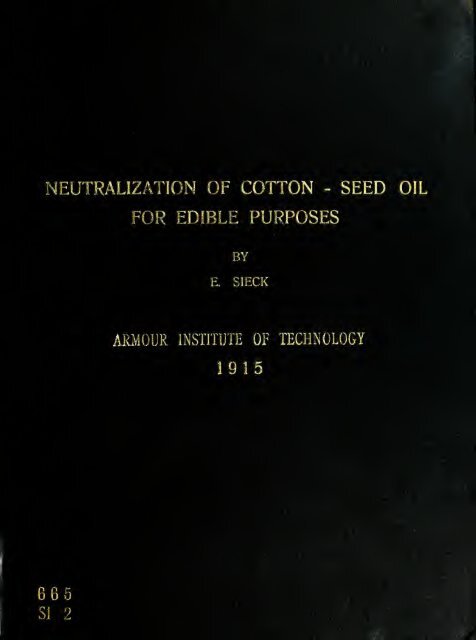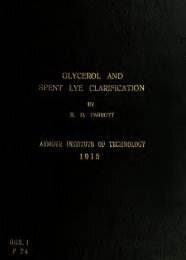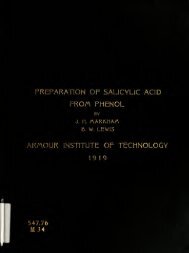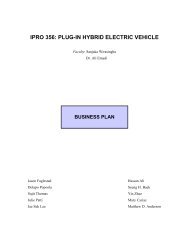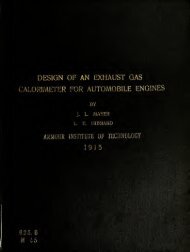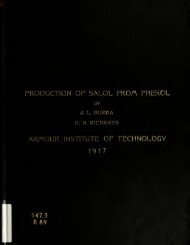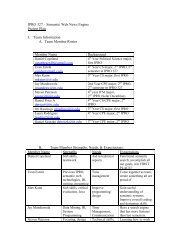The neutralization of cotton-seed oil for edible purposes
The neutralization of cotton-seed oil for edible purposes
The neutralization of cotton-seed oil for edible purposes
You also want an ePaper? Increase the reach of your titles
YUMPU automatically turns print PDFs into web optimized ePapers that Google loves.
NEUTRALIZATION OF COTTON * SEED OIL<br />
665<br />
SI 2<br />
FOR EDIBLE PURPOSES<br />
SIECl<br />
M1UU DMATTER INSTITUTE IMC OF TECHNOLOGY<br />
1915
Illinois Institute<br />
<strong>of</strong> Technology<br />
UNIVERSITY LIBRARIES
AT 390<br />
Sieck, e.<br />
<strong>The</strong> <strong>neutralization</strong> <strong>of</strong><br />
<strong>cotton</strong>-<strong>seed</strong> <strong>oil</strong> <strong>for</strong> <strong>edible</strong><br />
For Use In Library Only
THE NEUTRALIZATION OP COTTON-SEED OIL<br />
FOR EDIELE PURPOSES.<br />
M<br />
A THESIS pT!/^ T<br />
w UTEOFTtCHNOl -OGy<br />
PAUL V. GALVIU LIBRARY<br />
presented BY 35 WEST 33RD STREET<br />
CHICAGO, IL 60616<br />
ERNST SIECK<br />
to the<br />
PRESIDENT AND FACULTY<br />
<strong>of</strong><br />
ARMOUR INSTITUTE OF TECHNOLOGY<br />
FOR THE DEGREE OF<br />
EACKELOR OF SCIENCE IN CHEMICAL ENGINEERING<br />
APPROVED<br />
OF STUDY IN<br />
CHEMICAL ENGINEERING.<br />
1915.<br />
Pr<strong>of</strong>essor <strong>of</strong> Chemical Engineering.<br />
»......v****« • *•<br />
Dean <strong>of</strong> Engineering Studies.
INTRODUCTION.<br />
In view <strong>of</strong> the fact that the <strong>cotton</strong>-<strong>seed</strong><br />
industry is now sunplyi^g us with most <strong>of</strong> the<br />
fat substitutes, the author has endeavored to<br />
orepare a neutral <strong>oil</strong> <strong>for</strong> <strong>edible</strong> <strong>purposes</strong>. <strong>The</strong><br />
experiments were made under varying conditions<br />
in order to obtain the best efficiency in the<br />
refining nrocess<br />
.<br />
Lost <strong>of</strong> the in<strong>for</strong>mation was taken <strong>for</strong>m var.<br />
ious text-books, a^d from the United States<br />
Consular Reports.<br />
<strong>The</strong> author wishes to thank Pr<strong>of</strong>essor Lac<br />
Cormack <strong>for</strong> the services rendered in the pre-<br />
paration <strong>of</strong> this thesis.
TAELE OP CONTENTS.<br />
History <strong>of</strong> <strong>The</strong> Cotton-<strong>seed</strong> Industry 1<br />
Pressing and Refining <strong>of</strong> Cotton-<strong>seed</strong> Oil 3<br />
Use <strong>of</strong> Cotton-<strong>seed</strong> Oil is Foreign<br />
Countries. 10<br />
Cotton-<strong>seed</strong> Meal and Its Uses. 13<br />
Cotton-<strong>seed</strong> Oil Characteristics. 16<br />
Neutralization <strong>of</strong> Cotton-<strong>seed</strong> Oil <strong>for</strong><br />
Edible <strong>purposes</strong> by Caustic. 18<br />
Experimental Runs, Numbers I to XII. 20-31<br />
Explanation <strong>of</strong> Sumary. 32<br />
Conclusion. 34<br />
Exportations <strong>of</strong> Cotton-<strong>seed</strong> <strong>oil</strong> and<br />
its By- products from United States 35<br />
International Cotton-<strong>seed</strong> Trade 36<br />
PLATES<br />
I. Sumary <strong>of</strong> Neutralization Experiments.<br />
II. Neutralization Curves.
Kistiry <strong>of</strong> the Cotton-Seed<br />
Industry.<br />
<strong>The</strong> <strong>cotton</strong>-<strong>seed</strong> was considered a nuisance<br />
unon the plantations up to the year 1870. It<br />
was dumped in large heaps, or thrown into<br />
the streams. If the <strong>seed</strong> was allowed accum-<br />
ulate ard rot, it was poisonous to the cattle<br />
or the hops eating it. <strong>The</strong> <strong>seed</strong> was difficult<br />
to burn, and when it was disposed <strong>of</strong> in the<br />
streams, it decayed and gave <strong>of</strong>fensive odors<br />
wherever it collected. <strong>The</strong> fresh <strong>seed</strong> was<br />
used to a small extent <strong>for</strong> food <strong>for</strong> milch<br />
cows, and fertilizer, but this was an unsys-<br />
tematic disposal <strong>of</strong> a valuable by-product.<br />
<strong>The</strong> first mills were established in the<br />
early fifties and ten year later only seven<br />
mills were in operation. This young industry<br />
was interupted by the civil war, and it was<br />
not until 1668 that the mills began operating<br />
again. In 18^0 there were 25 mills in the<br />
southern states, 50 in I860, and 500 in 1901,<br />
one third <strong>of</strong> which were in Texas.
2<br />
<strong>The</strong> growth <strong>of</strong> the industry in last years<br />
has beer very pre at . Because <strong>of</strong> the high prices<br />
<strong>of</strong> the animal shortenings and hutters, a great<br />
many <strong>of</strong> substitutes have come or. the market,<br />
the chief constituent <strong>of</strong> which is <strong>cotton</strong>-<strong>seed</strong><br />
<strong>oil</strong> in some <strong>for</strong>m or other. <strong>The</strong> recent devel-<br />
opements in the hyrdogenation <strong>of</strong> <strong>oil</strong>s has open-<br />
a new field to the compound manufactures, res-<br />
ulting in some remarkable products which have<br />
won favor with the public.<br />
<strong>The</strong> increase <strong>of</strong> price <strong>of</strong> the fertilizers and<br />
the cattle food has given the <strong>cotton</strong>-<strong>seed</strong> meal<br />
a chance to show what a wonderful by product<br />
it is
3<br />
Pressing and Refining <strong>of</strong><br />
Cotton-<strong>seed</strong> <strong>oil</strong> .<br />
<strong>The</strong> products <strong>of</strong> <strong>cotton</strong>-<strong>seed</strong> have become one<br />
<strong>of</strong> the most important exports <strong>of</strong> this country.<br />
<strong>The</strong> main product being the refined <strong>oil</strong>, which<br />
is used as an olive <strong>oil</strong> substitute, or mixed<br />
with beef products in the preparation <strong>of</strong> com-<br />
pound lards. <strong>The</strong> poorer grades <strong>of</strong> <strong>oil</strong> are em-<br />
ployed in the manufacture <strong>of</strong> soap, candles, and<br />
phonograph records. Miners <strong>oil</strong> consists <strong>of</strong> a<br />
mixture <strong>of</strong> bleached <strong>cotton</strong>-<strong>seed</strong> <strong>oil</strong> and kero-<br />
sine.<br />
<strong>The</strong> <strong>cotton</strong>-<strong>seed</strong> requires but one pressing,<br />
which is done by running the <strong>seed</strong> thru heat-<br />
ed rolls. <strong>The</strong>re are two varieties <strong>of</strong> <strong>seed</strong>,<br />
the black and the white. <strong>The</strong> black <strong>seed</strong>, that<br />
from the Egyptian plant, is quite free from<br />
adherent <strong>cotton</strong>. <strong>The</strong> American and the East<br />
Indian <strong>seed</strong> is <strong>of</strong> a light shade, and is cover*-<br />
ed with short fibers.<br />
In the United States and India, the husk <strong>of</strong><br />
the <strong>seed</strong> first removed, and only the kernels<br />
or the "meats" are pressed. This is termed aS
4.<br />
decorticating, and has come into use because<br />
<strong>of</strong> the better grade <strong>of</strong> meal which is produc-<br />
ed, and <strong>of</strong> the light color <strong>of</strong> the <strong>oil</strong> express-<br />
ed. Most <strong>of</strong> the <strong>oil</strong>s ape pressed abroad are <strong>of</strong><br />
a darker color, because <strong>of</strong> the coloring mat-<br />
ter extracted from the husks along with the<br />
<strong>oil</strong>. Since 50# <strong>of</strong> the <strong>seed</strong> is husk, it is ob-<br />
vious that an American mill has twice the cap-<br />
acity <strong>of</strong> a <strong>for</strong>eign one without a decortica-<br />
tor<br />
<strong>The</strong> color <strong>of</strong> the crude <strong>oil</strong> depends upon the<br />
freshness <strong>of</strong> the <strong>seed</strong>. <strong>The</strong> American <strong>seed</strong> is<br />
usually pressed imediatly after it is harvest-<br />
ed, and yields a crude <strong>oil</strong> much paler in color<br />
than that obtained in England, France, and<br />
Germany from Egyptian and other imported<br />
<strong>seed</strong>. TJhen the <strong>seed</strong> has been stored <strong>for</strong> sev-<br />
eral months, it undergoes some deterioration,<br />
and gives a very dark <strong>oil</strong> on pressing.<br />
In the American trade three grades <strong>of</strong> <strong>oil</strong><br />
are recognized, viz. prime, choice, and <strong>of</strong>f<br />
qualities.<br />
Prime <strong>cotton</strong>-<strong>seed</strong> <strong>oil</strong> must be made from
sound decorticated <strong>seed</strong>, must be free from<br />
water and foots, and must be sweet in flav-<br />
or and odor. It should oroduce prime summer<br />
<strong>oil</strong> when refined with caustic soda, with a<br />
loss not exceeding 9JjJ. Should the loss in re-<br />
fining be greater than 9"7,but the oi obtain-<br />
be still prime summer oiKit cannot be re-<br />
jected by the buyer), the price must be reduc-<br />
ed by a corresponding amount.<br />
Choice crude <strong>oil</strong> must be manufactured from<br />
sound decorticated <strong>seed</strong>, must be free from water<br />
and foots, sweet in flavor and odor, and should<br />
be nroduced by the proner methods <strong>of</strong> refining<br />
choice summer <strong>oil</strong> ,with no greater loss in wei-<br />
ght than 6# <strong>for</strong>, Texas <strong>oil</strong> and 7# <strong>for</strong>n <strong>oil</strong> from<br />
<strong>seed</strong>s grown in otber states. <strong>The</strong> percentage <strong>of</strong><br />
free fatty acids should not exceed 1% S as oleic<br />
acid<br />
Qualities which correspond to neither <strong>of</strong><br />
the grades mentioned, are termed as "<strong>of</strong>f"<br />
<strong>oil</strong>s, and are sold by sample.<br />
<strong>The</strong> <strong>oil</strong> from the presses is run into large
tanks and allowed to stand <strong>for</strong> some time. <strong>The</strong><br />
dirt and other impurities settle to the bot-<br />
tom, and leave clear <strong>oil</strong> on top. <strong>The</strong> tanking<br />
or settling is a lenthy process and is not<br />
much in use at the present time.<br />
/jmuck quicker and thorough method <strong>of</strong> clari-<br />
fication is by the use <strong>of</strong> the filter press.<br />
<strong>The</strong> <strong>oil</strong> is <strong>for</strong>ced thru a succession <strong>of</strong> cloths<br />
on frames, and the solid matter is removed.<br />
<strong>The</strong> <strong>oil</strong> is then run into large tanks, con-<br />
taining steam c<strong>oil</strong>s, and mechanical stirrers.<br />
<strong>The</strong> <strong>oil</strong> is heated to 30°C . and the proper a-<br />
mour.t <strong>of</strong> 74° Ee. caustic is added, and the <strong>oil</strong><br />
agitated <strong>for</strong> about fifteen minutes.<br />
<strong>The</strong> <strong>oil</strong> is then cooled, and the soap set-<br />
tles out to the bottom in a blackish mass.<br />
<strong>The</strong> <strong>oil</strong> is drawn <strong>of</strong>f from the top, by means <strong>of</strong><br />
a suction pine, and washed free from caustic<br />
with water in a similar tank. <strong>The</strong> <strong>oil</strong> must be<br />
washed well, so in some <strong>of</strong> the tanks it is heat-<br />
ed to 50°C, and air is blown thru it, CaSC^,<br />
or salt being added. <strong>The</strong> <strong>oil</strong> is then filtered
to remove any <strong>of</strong> the solid matter.<br />
If the <strong>oil</strong> is dark in color, it is agit-<br />
ated in a tank with about 3.5$ <strong>of</strong> Fuller's<br />
earth, and the filter pressed. <strong>The</strong> <strong>oil</strong> must<br />
not remain in contact with the earth <strong>for</strong><br />
more than fifteen minutes, otherwise it will<br />
acquire an earthy taste, and be unfit <strong>for</strong> ed-<br />
ible <strong>purposes</strong>.<br />
<strong>The</strong> soap or "mucilage" contains some <strong>of</strong> the<br />
neutral oi which has been carried down mechan-<br />
ically, or has become emulsified by the soap<br />
solution. <strong>The</strong> mucilage from fresh <strong>oil</strong> espec-<br />
ially American, is light in color. A large<br />
quantity <strong>of</strong> the mucilage is made into soap,<br />
by removing the bulk <strong>of</strong> the coloring matter<br />
by "cutting" the soap with alkali.<br />
<strong>The</strong> three kinds <strong>of</strong> refined <strong>oil</strong> are, Prime<br />
summer <strong>oil</strong>, Choice summer yellow, and "<strong>of</strong>f"<br />
summer yellow. <strong>The</strong> Prime summer yellow is re-<br />
quired to be clear and free from water, sweet<br />
in flavor and color. <strong>The</strong> choice summer <strong>oil</strong><br />
must be clear, free from moisture, and sweet
8<br />
in flavor and odor. <strong>The</strong> "<strong>of</strong>f" summer <strong>oil</strong> must<br />
be free from water and foots, and nay be <strong>of</strong><br />
a lower quality in regards taste and odor.<br />
<strong>The</strong> summer and the winter <strong>oil</strong>s differ from<br />
each other in that the latter has most <strong>of</strong><br />
the stearine removed, so that the <strong>oil</strong> will<br />
not solidify during the colder months. <strong>The</strong><br />
process <strong>for</strong> making winter <strong>oil</strong> is known as<br />
chilling, by which the stearine is precipi-<br />
tated out. <strong>The</strong> tank used is insulated, and<br />
contains a series <strong>of</strong> cooling c<strong>oil</strong>s, and a<br />
per<strong>for</strong>ated ring at the bottom <strong>of</strong> the tank<br />
thru which air may be blown.<br />
<strong>The</strong> <strong>oil</strong> is run into the tank, and chilled<br />
to about 32°F., temperature observations be-<br />
ing taken at regular intervals. <strong>The</strong> control<br />
is had be ascertaining the fall and subse-<br />
c ,<br />
quent rise in temperature which e^curs dur-<br />
ing the operation. At first the temperature<br />
falls, until the stearine commences to separ-<br />
ate out, the a rise occurs due to the separ-<br />
ation. In the meantime the <strong>oil</strong> has been thorough-<br />
ly agitated by the air which has been blown
thru it from the ring. When the temperature<br />
remains stationary, the process is finished,<br />
and the <strong>oil</strong> is withdrawn, and sent thru a<br />
filter press.<br />
<strong>The</strong> <strong>cotton</strong>-<strong>seed</strong> stearine is <strong>of</strong> a light yel-<br />
low color, and <strong>of</strong> the consistency <strong>of</strong> butter.<br />
It is used as one <strong>of</strong> the ingredents <strong>of</strong> <strong>cotton</strong>-<br />
<strong>seed</strong> shortenings, or butter substitutes.
<strong>The</strong> use <strong>of</strong> Cotton-<strong>seed</strong> Oil in<br />
Foreign Countries.<br />
In Italy, olive <strong>oil</strong>, <strong>for</strong> both retail and<br />
wholesale <strong>purposes</strong> contains from 5 to 50#<br />
<strong>of</strong> <strong>cotton</strong>-<strong>seed</strong> <strong>oil</strong>, and is in competition<br />
with the <strong>for</strong>mer as well as with <strong>edible</strong> tallow<br />
butter, lard, oleomargarine, peanut and flax<br />
<strong>seed</strong> <strong>oil</strong>s. <strong>The</strong>re has been little or no loaded<br />
olive <strong>oil</strong> sent to the United States. <strong>The</strong> cot-<br />
ton-<strong>seed</strong> <strong>oil</strong> is used to give the olive <strong>oil</strong> a<br />
brilliant yellow color, and by the middleman<br />
to pad his stock.<br />
<strong>The</strong> <strong>cotton</strong>-<strong>seed</strong> <strong>oil</strong> is used <strong>for</strong> diltuing<br />
the olive <strong>oil</strong>, and as an <strong>edible</strong> substitute<br />
<strong>for</strong> the same, at a lower price. In 1905 when<br />
the olive crop in Italy was poor, the <strong>cotton</strong><br />
<strong>seed</strong> <strong>oil</strong> iirmortatior.s amounted to lOf <strong>of</strong> the<br />
total home consumption <strong>of</strong> olive <strong>oil</strong>, and to<br />
6# <strong>of</strong> the amount <strong>of</strong> <strong>oil</strong> imported.<br />
Five percent <strong>of</strong> <strong>cotton</strong>-<strong>seed</strong> <strong>oil</strong> may be add-<br />
ed to oline <strong>oil</strong> without altering the taste or<br />
the color, <strong>of</strong> the same. <strong>The</strong> American <strong>oil</strong> is pre-<br />
fered to the second grade <strong>of</strong> olive <strong>oil</strong> ( olia<br />
catteraj, and is being sold in great quantit-
11<br />
ies at a low price. This <strong>cotton</strong>-<strong>seed</strong> <strong>oil</strong> is<br />
sold at 8 cents per pound while the price <strong>of</strong><br />
olive <strong>oil</strong> ranges from 11.5 to 14 cents per<br />
pound <strong>for</strong> first pressed <strong>oil</strong>. <strong>The</strong> following<br />
is a list <strong>of</strong> the fats used in Italy, and the<br />
average price per pound in cents.<br />
Amount Used. Price ( cts.).<br />
Olive Oil. 372,000,000 lbs. 8.5 per lb.<br />
Lard. 273,000,000 " 12.5<br />
Putter. 75,152,900 " 21.0<br />
Lin<strong>seed</strong> Oil .29,6*1,000 " 6.5<br />
Cotton-<strong>seed</strong><br />
Oil. 9,256,303 H 4.2<br />
Tallow 31,143,000 " 10.0<br />
In Prance most <strong>of</strong> the <strong>cotton</strong>-<strong>seed</strong> <strong>oil</strong> is<br />
used <strong>for</strong> making oleomargarine, compound lards,<br />
and other <strong>edible</strong> fats, <strong>for</strong> which over 10,000,<br />
000. kilos is used yearly. <strong>The</strong> sale <strong>of</strong> adult-<br />
erated olive <strong>oil</strong> is prohibited by law, so not<br />
much <strong>oil</strong> is sold in this <strong>for</strong>m. <strong>The</strong> Egyptian<br />
and the Indian <strong>oil</strong>s are used <strong>for</strong> soap, as<br />
they are dark in color and rankish in taste.'<br />
<strong>The</strong> <strong>cotton</strong>-<strong>seed</strong> <strong>oil</strong> meets many compedit-<br />
ors in Prance, buts its use in cooking is<br />
steadily increasing. <strong>The</strong> fact that the <strong>oil</strong><br />
can be used over and over again, since it
1£<br />
does absorb the taste <strong>of</strong> the fried food, is<br />
the reson <strong>for</strong> its popularity.<br />
<strong>The</strong> <strong>oil</strong> is used in Germany wher it is in<br />
the nrirne state <strong>for</strong> compounding, and other<br />
<strong>edible</strong> <strong>purposes</strong>. It is being substituted <strong>for</strong><br />
olive <strong>oil</strong> <strong>for</strong> table and culinary <strong>purposes</strong>.<br />
<strong>The</strong>re is some adulteration <strong>of</strong> olive <strong>oil</strong> here<br />
as well as in the other countries, but the<br />
strict pure food laws make it impossible <strong>for</strong><br />
the <strong>oil</strong> to be sold as nure olive.<br />
Holland and Belgium are large users <strong>of</strong> cot-<br />
ton-<strong>seed</strong> <strong>oil</strong>. It is used <strong>for</strong> the same purpos-<br />
es as in the three countries mentioned. <strong>The</strong>se<br />
two countries do a large amount <strong>of</strong> compound-<br />
ing <strong>for</strong> the Orient, and the <strong>oil</strong> and its pro-<br />
ducts are rapidly finding a place in the East-<br />
ern markets<br />
<strong>The</strong> fact that oli is a pure vegetable <strong>oil</strong>,<br />
and that compounds <strong>of</strong> the same kind can be<br />
prepared, gives these a place in the Indian<br />
and Jewish markets.
13<br />
Cotton-<strong>seed</strong> Meal and<br />
its uses.<br />
One thousand pounds <strong>of</strong> <strong>seed</strong> are produced<br />
<strong>for</strong> every five hundred pounds <strong>of</strong> <strong>cotton</strong> that<br />
are brought on the market. On the basis <strong>of</strong><br />
a 10,000,000 bale crop, 5,000,000 tons <strong>of</strong> <strong>seed</strong><br />
are nroduced. Only about 3,000,000 tons <strong>of</strong> this<br />
are pressed, ard the remaining 2,000,000 tons<br />
are used on the farms as cattle food or fer-<br />
tilizer. This small percentage <strong>of</strong> pressing<br />
is due to the bad roads and high freight<br />
rates, which prevent the farmer from send-<br />
ing his <strong>seed</strong> to the mills. <strong>The</strong> Upland <strong>seed</strong><br />
gives the following analysis;<br />
Nitrogen-?. 07# , Phosphoric Acid-1.02^, and<br />
Potash -1.79??.<br />
Besides this there are small amounts <strong>of</strong> lime<br />
magnesia etc in the <strong>seed</strong>. <strong>The</strong> Sea Island <strong>seed</strong><br />
is more valuable than the Upland, and has the<br />
following analysis;<br />
Nitrogen-6.79^, Fhosphoric Acid-2.88^, and<br />
Potash 1.7Q*.
14.<br />
Using, the average price <strong>for</strong> nitrgen, phos-<br />
phoric acid, and potash compounds when bought<br />
in large quantities <strong>for</strong> fertilizing <strong>purposes</strong><br />
we find that a ton <strong>of</strong> <strong>seed</strong> is worth #23.80<br />
when used as a fertilizer.<br />
<strong>The</strong> <strong>cotton</strong>-<strong>seed</strong> meal is made by grinding<br />
the cake which is left when the <strong>oil</strong> has been<br />
extracted from the meat. <strong>The</strong> meals which have<br />
been damaged by over heating, cannot be used<br />
as cattle food, but are very good nitrogen<br />
providing fertilizers. <strong>The</strong> regular meals are<br />
one <strong>of</strong> the best cattle foods that we have, as<br />
the following analysis show;<br />
Proteins Carbohydrates Fats Ash.<br />
fc.eal 43.26 22.31 13.45 7.02<br />
Corn 10.50 ^0.00 5.51 1.02<br />
Oats 17.11 65.02 8.00 1.24<br />
Although the meal is low in carbohydrates, it<br />
is high in fats and proteins, which makes it<br />
an ideal cattle food.<br />
Crude <strong>seed</strong> cake is made from decorticated<br />
<strong>seed</strong> contains as much as 5$ <strong>of</strong> <strong>oil</strong>. <strong>The</strong> hus-<br />
ks which remain are not detremental to the<br />
cattle as long as the " non-fuzzy" variety <strong>of</strong><br />
<strong>seed</strong> is employed.
15<br />
<strong>The</strong> fuzzy <strong>seed</strong> varieties should not be<br />
used in the nondecorticated state <strong>for</strong> the<br />
production <strong>of</strong> cake, as the small fibers <strong>for</strong>m<br />
harmful " balls " in the stomach <strong>of</strong> the cat-<br />
tle. <strong>The</strong> decorticated cakes are usually ground<br />
to meal, and exported to Europe in this <strong>for</strong>m.<br />
As the American meal is light colored, attem-<br />
pts have been made, especially on the Contin-<br />
ent, to bleach inferior meal by adding small<br />
quantities <strong>of</strong> borax etc.
lfi<br />
Cotton-<strong>seed</strong> Oil Characteristics.<br />
Cotton-<strong>seed</strong> <strong>oil</strong> is a mixture <strong>of</strong> several<br />
glycerides <strong>of</strong> different chemical and physic-<br />
al properties. <strong>The</strong>se glycerides in the aggre-<br />
gate produce the characteristics <strong>of</strong> the <strong>oil</strong> it«<br />
self. <strong>The</strong> absence <strong>of</strong> any <strong>of</strong> these, changes the<br />
property <strong>of</strong> the <strong>oil</strong>.<br />
<strong>The</strong> <strong>oil</strong> is present in the cells <strong>for</strong>ming the<br />
<strong>seed</strong> embryo. This <strong>oil</strong> is the food <strong>of</strong> the em-<br />
bryo during the early stages <strong>of</strong> develope-<br />
ment when it cannot get food from outside sour-<br />
ses<br />
Cotton-<strong>seed</strong> <strong>oil</strong> is a semi-drying <strong>oil</strong>, as it<br />
is intermediate in the readiness with which<br />
it absorbs oxygen. This is due to the presence<br />
<strong>of</strong> the glycerides <strong>of</strong> the unsaturated fatty<br />
acids which are present in the <strong>oil</strong>. <strong>The</strong> <strong>oil</strong><br />
also contains the glycerides <strong>of</strong> the unsatur-<br />
ated hydroxy acids, varying amounts <strong>of</strong> col-<br />
oring matter, to gether with complex and un-<br />
stable nitrogonous compounds. <strong>The</strong> specific
17<br />
gravity depends upon the purity, temperature,<br />
and the amount <strong>of</strong> solid glycerides present.<br />
<strong>The</strong> following constants <strong>of</strong> <strong>cotton</strong>-<strong>seed</strong> <strong>oil</strong><br />
will serve to identify the <strong>oil</strong>.<br />
Specific Temnerature Reaction 140-170<br />
Saponification Number 190-197<br />
Iodine Number 104-116<br />
Specific Gravity 15.5°C. .920-. 925<br />
Index <strong>of</strong> refraction 1.4735-1.4760<br />
Keat <strong>of</strong> Combustion 9,395 Cal.
le<br />
Neutralization <strong>of</strong> Cotton-<strong>seed</strong> Oil<br />
<strong>for</strong> Edible Purposes by Caustic.<br />
<strong>The</strong> object <strong>of</strong> the work as presented in this<br />
thesis was to remove as great a precentage <strong>of</strong><br />
the free fatty acids from the <strong>oil</strong> as possible<br />
with one treatment with sodium hydroxide. At<br />
the same time, the percentage <strong>of</strong> less due to<br />
the <strong>for</strong>mation <strong>of</strong> soap was to be kept as low<br />
as possible, in Oder to make the operation an<br />
efficient one.<br />
<strong>The</strong> Interstate Cotton-<strong>seed</strong> Crushers Associat-<br />
ion gives the following directions <strong>for</strong> the<br />
<strong>neutralization</strong> <strong>of</strong> the <strong>oil</strong>.<br />
" 500 grams <strong>of</strong> <strong>oil</strong> are weighed out into a bea~<br />
ker, and heated to 75 or 80°P. <strong>The</strong> lye, from<br />
10 to 20° Be. is added, and the <strong>oil</strong> stirred<br />
<strong>for</strong> fifteen minutes, keeping the temperature<br />
about the same. <strong>The</strong> beaker is then placed in<br />
hot water and the temperature raised to 11C°F.<br />
in fifteen minutes, the <strong>oil</strong> being stirred un-<br />
til the soap starts to settle out in large<br />
flakes. <strong>The</strong> <strong>oil</strong> should never be heated over<br />
125°P. to bring down the soap, as much <strong>of</strong> it<br />
will dissolve in the <strong>oil</strong>. <strong>The</strong> beaker is then
19<br />
heated on a water bath at 12f°F. <strong>for</strong> three<br />
hours, and allowed to stand over night, or<br />
placed in cold water until the <strong>oil</strong> has been<br />
chilled.<br />
This method was followed in a general way,<br />
the amounts <strong>of</strong> alkali being varried, but the<br />
temperature changes kept the same so that a<br />
comparison <strong>of</strong> the action <strong>of</strong> the alkali was<br />
made.<br />
<strong>The</strong> last runs were made at higher temperature<br />
in order to see how this affected the amount and<br />
the precipitation <strong>of</strong> the soap <strong>for</strong>med. <strong>The</strong> curve<br />
shown on one <strong>of</strong> the following pages, was plot-<br />
ted from data from runs under the same condit-<br />
ions, and from the same lot <strong>of</strong> <strong>oil</strong>.<br />
It the other runs, the fatty a^ids were added<br />
to the <strong>oil</strong> in the <strong>for</strong>m <strong>of</strong> oleic acid. <strong>The</strong> <strong>oil</strong> us-<br />
ed <strong>for</strong> the first six runs contained 1. 18?? <strong>of</strong> free<br />
fatty acids.
20<br />
Number I<br />
500 prams <strong>of</strong> <strong>oil</strong> were weighed into a beaker<br />
and heated on the water bath to 75°F. 18.3 c.c.<br />
<strong>of</strong> 97^ triple normal NaOH, 2.54 times theoret-<br />
ical, were slowly added, and the <strong>oil</strong> stirred <strong>for</strong><br />
five minutes. <strong>The</strong> temperature was then raised<br />
to 11C°P. in fifteen minutes, when the soap<br />
settled out in large flakes. <strong>The</strong> <strong>oil</strong> was kept<br />
at 125°F. <strong>for</strong> two hours, and allowed to stand<br />
over night.<br />
<strong>The</strong> <strong>oil</strong> was then noured from the top, and<br />
the soap was found as a solid mass <strong>of</strong> butter<br />
like constituency. It was tan in color, with<br />
darker pieces mixed in with it. <strong>The</strong> <strong>oil</strong> had<br />
a cloudy appearenc, but filtered clear thru<br />
paper.<br />
Oil remaing 467 gms.or 93. 5% Shrinkage 6.5f<br />
Free fatty acids in <strong>oil</strong> 0.09?
21<br />
Number II.<br />
750 grams <strong>of</strong> <strong>oil</strong> were placed in a stirring<br />
machine, and heated to 73°F. by the aid <strong>of</strong> the<br />
<strong>oil</strong> bath. 34.4 c.c. or 3.19 times the theoret-<br />
ical amount, <strong>of</strong> alkali were added, and the <strong>oil</strong><br />
agitated <strong>for</strong> five minutes. <strong>The</strong> temperature had<br />
risen to 80 Pi, by this time and more heat was<br />
applied, and the <strong>oil</strong> stirred intermittently,<br />
until the tomoerature reached 125°F., when the<br />
soap started to settle out in large brown flak-<br />
es. <strong>The</strong> temperature was kept constant <strong>for</strong> about<br />
45 minutes, and the <strong>oil</strong> chilled in cold water.<br />
<strong>The</strong> soap separated out on the bottom as be<strong>for</strong>e.<br />
Oil remaining 673 gms.or 90.0$ Shrinkage 10.0??<br />
Free fatty acids in <strong>oil</strong> 0.05??
22<br />
Number III.<br />
500 grams <strong>of</strong> <strong>oil</strong> were neutralized with 55.<br />
c.c. or 4.68 times theoretical, <strong>of</strong> alkali.<br />
<strong>The</strong> alkali was added at 75°F., and the solution<br />
heated to 120°?. after five minuter, neutral-<br />
ization. It was allowed to remain at this temp-<br />
erature <strong>for</strong> about one hour, and then colled in<br />
a cold water bath. <strong>The</strong> soap <strong>for</strong>med was as in the<br />
other two runs<br />
Oil remaining- 4-40 gms.or 88. 0# Shrinkage 12.0^<br />
Free fatty acids in <strong>oil</strong> 0.05#
23<br />
Number IV.<br />
Since there was a large loss in No. Ill, and<br />
no great removal <strong>of</strong> the fatty acids, only 30<br />
c.c. or 4.1fi times theoretical were added to<br />
500 grams <strong>of</strong> <strong>oil</strong>. <strong>The</strong> <strong>oil</strong> was neutralized at<br />
75°F. <strong>for</strong> five minutes, and then heated to 125°<br />
P. until the soap settled out. It was allowed to<br />
stand <strong>for</strong> one hour, and then colled as be<strong>for</strong>e.<br />
Oil remaining 4.67 gms.or 93. 4# Shrinkage 7 .&%<br />
Free fatty acids in <strong>oil</strong> .025$
24<br />
Number V.<br />
In this run alarge amount <strong>of</strong> alkali, 45 c.c.<br />
or 6:34 times theoretical were added to remove<br />
all traces <strong>of</strong> the acid without regards to the<br />
amount <strong>of</strong> soap <strong>for</strong>med. <strong>The</strong> alkali was added<br />
to the <strong>oil</strong> at 75°P., and stirred <strong>for</strong> ten min-<br />
utes. It was then heated to 95°F. when the<br />
soap started to settle out. <strong>The</strong> <strong>oil</strong> was not st-<br />
irred while heating, the temperature being al-<br />
lowed to go up to 106°F. <strong>The</strong> <strong>oil</strong> was allowed to<br />
stand over night, and a very fine separtion was<br />
had. <strong>The</strong> <strong>oil</strong> was clear, but quite a lot <strong>of</strong> soap<br />
was <strong>for</strong>med<br />
Oli remaining 455 gms.or 91. 0# Shrinkage 9.0#<br />
Free fatty acids in <strong>oil</strong> 0.01^.
25<br />
Number VI<br />
This run was made after the results furn-<br />
ished by No. V. 500 grams <strong>of</strong> <strong>oil</strong> were neu-<br />
tralized with 25 c.c. <strong>of</strong> alkali at 75°F. <strong>for</strong><br />
five minutes, and then heated to 125 F. <strong>The</strong><br />
soap settled out very well at this temperature,<br />
and so the <strong>oil</strong> was chilled <strong>for</strong> fifteen minutes<br />
after settling. It was then heated up to 75°F.<br />
again, 12.5 c.c. <strong>of</strong> alkali were added, and the<br />
<strong>oil</strong> heated and cooled as be<strong>for</strong>e. <strong>The</strong> <strong>oil</strong> was<br />
allowed to stand over night , and poured <strong>of</strong>f<br />
and weighed. <strong>The</strong> <strong>oil</strong> was rather cloudy, and<br />
the soap in two layers at the bottom <strong>of</strong> the<br />
beaker. Upon filtering the <strong>oil</strong>, it was clear<br />
and light in color. <strong>The</strong> total amount <strong>of</strong> alkali<br />
added was 37.5 c.c, or 4.3 times the theoret-<br />
ical .<br />
Oil remaining 467 gms.or 93.4?? Shrinkage 7.6^<br />
Free fatty acids in <strong>oil</strong> 9.00$
26<br />
Number VII<br />
<strong>The</strong> object <strong>of</strong> this and the following run,<br />
was to determine the affect <strong>of</strong> a great excess<br />
<strong>of</strong> alkali on a low free fatty acid <strong>oil</strong>. <strong>The</strong><br />
<strong>oil</strong> used contained only 0.2K# free fatty acids.<br />
To 475 grams <strong>of</strong> <strong>oil</strong>, 16.5 c.c. or 17. times the<br />
theoretical amount <strong>of</strong> alkali were added. <strong>The</strong> <strong>oil</strong><br />
was at 03°F., and was stirred <strong>for</strong> fifteen min-<br />
utes, and then heated to 11C°F. <strong>The</strong> soap was<br />
allowed to settle out without sitrring. After<br />
settling the <strong>oil</strong> was chilled and weighed. <strong>The</strong><br />
soap was <strong>of</strong> a ligher color and s<strong>of</strong>t.<br />
Oil remaining 4-60 gms. or 97. 0< Shrinkage 3.0$<br />
Free fatty acids in <strong>oil</strong> 0.034-f
27<br />
Number VIII.<br />
<strong>The</strong> sair.e <strong>oil</strong> was used in this run as in<br />
NO, VII. To 500 grams 25 cc or 20. times the<br />
theoretical amount, <strong>of</strong> alkali were added. <strong>The</strong><br />
<strong>oil</strong> was neutralized at a temperature <strong>of</strong> 102°F.<br />
<strong>for</strong> five minutes. <strong>The</strong> soap started to settle<br />
out as soon the stirring was stopped. <strong>The</strong> <strong>oil</strong><br />
was not chilled but allowed to stand over<br />
night. <strong>The</strong> <strong>oil</strong> which was poured <strong>of</strong>f the top<br />
had some jelly-like masses init which melted<br />
on slight heating. <strong>The</strong> soap was not as firm<br />
as that <strong>of</strong> the other runs.<br />
Oil remaining 457 gms.or 91.55? Shrinkage 8.5#<br />
Free fatty acids in <strong>oil</strong> 0.034$
28<br />
Number IX.<br />
This nm was made at a high temperature.<br />
<strong>The</strong> <strong>oil</strong> contained 2,56ft pf free fatty acids,<br />
and 27.3 c.c. or 2 times theoretical amounts<br />
<strong>of</strong> alkali were used. This was added to the at<br />
a temperature <strong>of</strong> 126°F., and thoroughly agitat-<br />
ed <strong>for</strong> five minutes. <strong>The</strong> soap started to settle<br />
out at once in very large light colored flakes.<br />
<strong>The</strong> soap on chilling, was s<strong>of</strong>t and jelly-like,<br />
and not stringy as that from the first five<br />
runs. <strong>The</strong> <strong>oil</strong> too was stiff and cloudy, being<br />
mixed with water and soap. It <strong>for</strong> this reason<br />
that the shrinkage was very small.<br />
Cil remaining 448 gms.or 98. 5# Shrinkage 1.5#<br />
Free fatty acids in <strong>oil</strong> 0.069#
29<br />
Number X.<br />
Prom the previous run it was seen that the<br />
temperature was just'a little too high, so<br />
this run was made with the same amount <strong>of</strong> al-<br />
kali at a lower temrerature. 515 grams <strong>of</strong> the<br />
<strong>oil</strong> were neutralized with 31.1 c.c. <strong>of</strong> alkali<br />
at 110 P. <strong>for</strong> five minutes. No heating was<br />
necessary as the soap settled very rapidly, a<br />
little slower than that in run No. IX. <strong>The</strong><br />
soap and <strong>oil</strong> were <strong>of</strong> the same consestency as<br />
that <strong>of</strong> the previos run.<br />
Oil remaining 484. gms.or 94, f< Shrinkage 6,0%<br />
Free fatty acids 0.052
30<br />
Number XI.<br />
<strong>The</strong> last two runs were made with <strong>oil</strong> con-<br />
taining 8.43# <strong>of</strong> free fatty acids. Twice the<br />
theoretical amount or 110 c.c. <strong>of</strong> alkali were<br />
used. <strong>The</strong> <strong>oil</strong> was heated to 83 P., and neut-<br />
ralized with the akali <strong>for</strong> five minutes. <strong>The</strong><br />
<strong>oil</strong>, 540 grams, was then heated to 120 P. <strong>for</strong><br />
ten minutes, and the soap allowed to settle out<br />
<strong>for</strong> two days. <strong>The</strong> <strong>oil</strong> was turbid, and the<br />
soat> very s<strong>of</strong>t and gelatinous.<br />
Oil remaining 472 gms.or 87. 5# Shrinkage 12. 5#<br />
Free fatty acids in <strong>oil</strong> 0.034#
31<br />
Number XII<br />
<strong>The</strong> same kind <strong>of</strong> <strong>oil</strong> was used in this run<br />
as in No. XI. <strong>The</strong> <strong>oil</strong> was heated to 125 F,<br />
and twice the theoretical amount <strong>of</strong> alkali<br />
was added. <strong>The</strong> <strong>oil</strong> was thoroughly agitated,<br />
and the soan allowed to settle out <strong>for</strong> two<br />
days. <strong>The</strong> nature <strong>of</strong> the <strong>oil</strong> and the soap<br />
was the same as in No. XI.<br />
Oil remaining 488 gms.or 90. 0# Shrinkage 10. 0#<br />
Free fatty acids in <strong>oil</strong> 0.023
32<br />
<strong>The</strong> table on the preceding page is a summary<br />
<strong>of</strong> the twelve runs. All <strong>of</strong> the figures are in<br />
precentage , and as nearly all <strong>of</strong> the column ex-<br />
plain themselves, it is not necessary to go in-<br />
to detail about each one. <strong>The</strong> last two columns<br />
were found by multiplying the sum <strong>of</strong> the fatty<br />
acids by the actual weight <strong>of</strong> the soap weigh-<br />
ed. This gives the shrinkage due to the <strong>for</strong>-<br />
mation <strong>of</strong> the soap, and does not take into ac-<br />
count emulsion <strong>of</strong> the <strong>oil</strong> and water which takes<br />
place. In the last four runs the calculated<br />
shrinkage is greater than that found by weigh-<br />
ing the <strong>oil</strong>, because much <strong>of</strong> the water was<br />
mixed with the <strong>oil</strong>, hence making it appear as<br />
though a greater quantity <strong>of</strong> <strong>oil</strong> was recover-<br />
ed.<br />
?he curves show in general the percent <strong>of</strong><br />
saponification and the percent <strong>of</strong> free fatty<br />
acids remaining after <strong>neutralization</strong>. <strong>The</strong>se<br />
curves are <strong>for</strong> the first five runs only, as<br />
the conditions <strong>of</strong> the other runs were dif-<br />
ferent, and the results would not fit in the
?££;::
curve.<br />
33<br />
<strong>The</strong> percentage <strong>of</strong> sanonification was found<br />
by multiplying the actual weight <strong>of</strong> the soap<br />
by the fatty acid content, and subtracting<br />
this amount from the inital free fatty acids<br />
in the <strong>oil</strong>.
34<br />
Conclusion.<br />
<strong>The</strong> twelve experiments on the neutralizat-<br />
ion <strong>of</strong> <strong>cotton</strong>-<strong>seed</strong> <strong>oil</strong> have caused the author<br />
to draw the following conclusions;<br />
I. <strong>The</strong> saponification <strong>of</strong> the <strong>oil</strong> at 70 to<br />
80°P. is almost directly proportional to the<br />
amount <strong>of</strong> alkali used.<br />
II. <strong>The</strong> removal <strong>of</strong> the free fatty acids is<br />
not proportional to the amount <strong>of</strong> alkali used,<br />
but depends upon the temperature regulation <strong>of</strong><br />
the solution .<br />
III. In order to remove the last traces <strong>of</strong><br />
free fatty acids, the process must be carried<br />
out in two <strong>neutralization</strong>s.<br />
VI. If <strong>neutralization</strong> is carried out at a<br />
temperature over 100°P., the water and the<br />
soap will mix with the <strong>oil</strong>, and a poor separ-<br />
ation will be had.<br />
V. Neutralization over 130°P. results in the<br />
<strong>for</strong>mation <strong>of</strong> a soapy foam, a very poor grade <strong>of</strong><br />
soap, which is difficult to separate.
35<br />
IV. Neutralization at low temperatures pro-<br />
duces a harder soap then at higher temperatures,<br />
IIV. <strong>The</strong> composition <strong>of</strong> the soap varies with<br />
each run, and no definite rule could be deduc-<br />
ed which would cover this feature.
*5<br />
Expectations <strong>of</strong> Cotton-<strong>seed</strong> Oil and its<br />
Ey-products from the United States.<br />
Cotton Seed Oil Meal Oil Oil<br />
Year. Seed Worked Pressed Cake Expted used in U.S.<br />
1906 5,600. 3,731. 155,700. 1,271. 43,793. 81,907.<br />
1907 5,912. 3,843. 153,760. 1,785. 41,880. 133,844.<br />
1908 4,952. 2,564. 103,049. 1,043. 41,029.<br />
1909 5,093. 3,669. 14-6,789. 1,491. 23,550.<br />
1910 4,462. 3,260. 131,000. 1,326.<br />
1911 5,175. 4,096. 167,970. 1,792.<br />
000. is omitted in all figures. <strong>The</strong> <strong>oil</strong> is listed<br />
in gallons, all others in tons <strong>of</strong> 2,000 lbs.
36<br />
International Cotton-<strong>seed</strong> Oil Trade.
•
6/ W5T y4c//?S //r/ c*7X>*/ y4//rc


